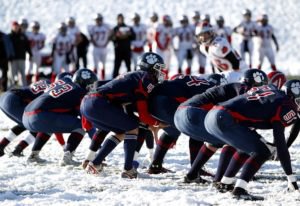The team has become a pervasive concept when talking about a manager and his directs. It is a useful metaphor, but it is incomplete by itself. Most people think of teams first as relating to sports and not horses or the workplace. Teams function differently in different sports. To succeed the manager and members of the sports team need to know what type of team they have. The late, great management thinker Peter F. Drucker calls out three types of teams in his opus Management. They are the baseball team, the football team, and the tennis doubles team.

Baseball Team
In a baseball team “the players play on the team; they do not play as a team.” Everyone has his position and sticks to it and it alone. You do not see the first basemen running into the outfield or the outfielder running to cover third base. Each stays in his own spot. This makes it easy to assess each person on his own work no matter how well or how poorly other members of the team perform.
In your organization, you have this type of team when one individual or group rarely interacts with another. The product design team doesn’t speak to finance and the marketers don’t speak to the design team. This has advantages in terms of specialization. Each person can have specific goals and be held accountable and rewarded for them. However, these teams are often inflexible and can fall prey to fast moving environments.

Football Team
The second kind of team is the [American] football team. All the players on the team have fixed positions, but they play as a team. When a lineman fails to pick up a block the running back steps in. Some players sole job is to enable the success of other players. All players are working together to score.
Many contemporary organizations are this type of team. This type of team requires unity of effort across the entire organization. Everyone must know what their part is and how it fits into the larger design. Unlike the baseball team, you just can’t head on to the field and react. The coach (the manager or executive) or team leader needs to call the play and disseminate it to the team. This requires more time and energy, but can yield great results. Additionally, there may be stars on this team, but they need to work well with everyone else on the team in order to succeed.

Tennis Doubles Team
In this final team, the players have a primary instead of fixed position. They adjust to the evolving demands of the game. The players have to train together and play together. Knowing how each other will behave in any situation that arises is key to success in a tough competitive environment.
This creates stringent requirements on the team. It has to be small (about half a dozen members); large teams fail to develop the cohesion necessary. Lots of time working and training together is required to develop the cohesion for the team to fully function as as team. Only the team performs; players only contribute. This is a very flexible team, but the effort to get there is quite high and the team’s capacity is capped.
Conclusion
The three types of teams each have their own advantages and disadvantages. When setting up a team or putting your team on a new project, determine which team for what purpose. What type of team do you have?
References
- Drucker, Peter F. Management, Revised Edition. 2008 (orig. 1973). Harper Business. New York. pp. 438-341
